|
The Begoniaceae is a family of 2 genera and around 1400 species of tropical flowering perennials including many stem succulents, mainly from America and Asia, with a few African species. The monotypic succulent genus Hillebrandia Oliver (1866) is native to the Hawaiian islands. All other species are included in Begonia which also lends its name to the Family Begoniaceae.
The genus Symbegonia Warburg (1905), a group of 12 species from New Guinea with distinctive tubular female flowers, was recently merged into Begonia.
|
|
Begonias are typical understory succulent plants in humid, tropical forests and cloud forests and rarely xerophytic. Most species are evergreen with fibrous roots. Some are tuberous with deciduous foliage. Stems are generally succulent with broad, asymmetrically shaped brittle peltate leaves, sometimes furnished with hairs especially on the undersides. Leaves of some cultivars may have decorative zonal markings. Flowers are unisexual with 2 - 5 prominant sepals, separate or absent petals, 4 to many stamens and 2 - 5 carpels. In some species the male flowers are smaller and much less showy than the female flowers.
Begonias are cultivated for decorative effect, popular as free-flowering houseplants and for summer bedding. They grow well in any general free-draining potting compost and require regular watering. Root and stem rot occur easily if the compost remains excessively wet for prolonged periods. Sudden changes in growing conditions may cause flower buds and leaves to drop.
Most species can be readily propagated by stem cuttings. Begonia rex is noteworthy as it will form plantlets from leaves laid on the surface of the soil and cut across their width.
|
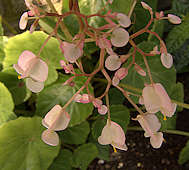
|
Begonia conchifolia Dietrich 1851
A species with a rhyzome that may be divided to propagate the plant. The glossy pelatate leaves were originally thought to resemble conch shells. Native to rain-forests of Costa Rica and Panama.
|
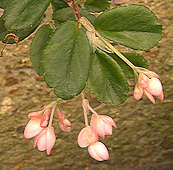
|
Begonia fuchsioides Hooker 1847
|
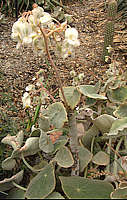
|
Begonia peltata Otto & Dietrich 1841 Syn. Begonia incarnata Link & Otto 1828
This freely-branching shrubby stem succulent has white felting on the fleshy stems and circular green leaves giving them a silvery colour. The inflorescence is a raceme of white to pale pink flowers.
Native to Veracruz, Mexico and Guatemala. One of the few species adapted to dryish conditions and should be watered carefully. It is best to keep water off the foliage to preserve the silvery felting.
|
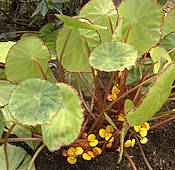
|
Begonia quadrialata Warburg 1895
|
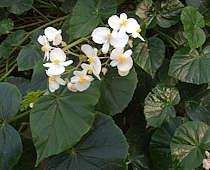
|
Begonia radicans Vellozo 1831 (Shrimp Begonia)
A scrambling succulent sub-shrub with bright green peltate leaves and clusters of small coral-pink flowers.
Native to forest floors of Eastern Brazil.
Left: Begonia sandersii Hort. Kean
is considered synonymous with Begonia radicans but has small white flowers.
|

 Families of Succulent Plants
Families of Succulent Plants 








